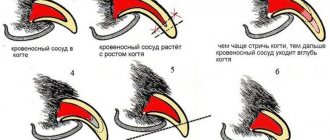Growth in different breeds is uneven: a baby toy terrier finishes developing at six months, while the body of a giant St. Bernard will begin to correspond to adult parameters only by the age of three. As for mongrels, you can't tell with them unless you look at the parents. After all, it is unknown what genes they inherited and what breeds are mixed in their blood.
Moreover, the size depends not only on the breed and parents, but also on how the puppy ate and in what conditions it grew until growth stopped.
From the article you will learn about the different stages of growth, what affects it, and how breeds of different sizes grow to age.
Stages of development
We found out how many months dogs grow. It all depends on the specific breed. Simultaneously with growth, the puppy develops. If the pet receives adequate nutrition during this period, then problems should not arise.
The very first stage of development is intrauterine. The puppy is being formed, its organs, tissues, and skeleton are being formed. This is why a pregnant dog needs proper care and a balanced diet. Poor nutrition and maintenance affect the development of the fetus inside the mother.
The second stage occurs during the puppy's suckling period. It lasts from birth to 1.5-2 months. At this time, the baby is actively gaining weight.
From the moment of weaning from the bitch until six months, the puppy is actively growing. He develops tubular bones. Active weight gain is underway, teeth are changing.
From six months to a year, the pet's height growth slows down. But flat bones begin to grow. And the puppy becomes more and more like an adult dog.
The fifth period lasts from one to two years. Growth stops, but the complete and final formation of the skeleton occurs. In addition, the animal continues to gain weight. Closer to two years, weight gain stops.
Prenatal period
Calcium for dogs of large, small and medium breeds
The period of development inside the womb is divided into several parts. The first stage is completed by the 18th day, development occurs due to food reserves. Next, the liver and kidneys are formed and blood circulation starts.
In the second stage, signs of pregnancy appear in the mother dog. The embryo takes on the shape of a mammal. The nose, eyes, jaws, limbs are formed, the fetus is rapidly increasing. At the end of this period, almost all formation ends, but hair does not appear.
During the last third period, the main growth process takes place: the development of the brain, respiratory tract, bone skeleton, digestion and genital organs.
Growth of representatives of large breeds
How long does it take for large breed dogs to grow? It depends on what variety we want to know about. Other representatives of canines are finally formed only by the age of three.
For most, height growth ends at 8-12 months.
How long does it take for Shepherd dogs to grow? If we are talking about German, then it is fully formed by 1.5 years. The active growth phase lasts up to 8 months, then slows down and stops for a year.
"Caucasians" are late dogs. These hulks grow up to 2 years. Full formation occurs by 3-3.5 years.
Central Asian Shepherds grow up to 3 years old. Taking into account the fact that they are finally formed closer to 4 years.
Toy Terrier
Let's consider another representative of small breeds. How many months do toy terrier dogs grow? On average, their rapid growth ends at the age of 7-10 months. Some individuals stop growing as early as six months, while others continue to grow up to 12 months. But the latter option is very rare. Most often, a toy terrier's growth stops when the puppy reaches 9 months.
Until about a year old, representatives of the breed have very fragile bones. This must be taken into account when the owner picks up the dog. And when playing with a dog, you should not allow the baby to jump and run too quickly.
Noble breed
If the growth of representatives of certain breeds is clear, then with mongrels nothing is clear. After all, it is unknown how many breeds are mixed in them. No one will say how many months mongrel dogs grow up to. Even the most experienced veterinarian or dog handler.
The fact is that such dogs have too much blood mixed in them. It is impossible to study its genetics, and accordingly, it is also impossible to predict growth.
Sometimes you can hear a recommendation: look at the puppy’s parents and understand how he will grow up. This only applies to purebred dogs. And you cannot rely entirely on visualization of parental growth. The puppy may grow larger or smaller. Mongrels are completely unpredictable in this regard. How can you predict the approximate height of a puppy if it has a large mother and a small father, for example? And even if both parents are large or small, it is possible that genetics will play a cruel joke, and the puppy will become as tall as its grandmother, who was slightly taller than a dachshund.
Advantages of mongrels
People who want to get a reliable friend and companion will like mongrels, and in some ways they are even superior to purebred dogs:
- They rarely suffer from hereditary diseases. Almost all mongrel puppies born on the street survive.
- Mutts are highly trainable. They do not have a built-in pattern with fixed instincts, like purebred dogs.
- Outbred dogs are distinguished by their endurance and unpretentiousness in food.
- They are unique - it is difficult to find two identical mongrels.
- The devotion of these dogs to their owner knows no bounds. Until his last days they will adore him, expressing great feelings of love and affection.
- In the role of a watchman or security guard, the mongrel is in no way inferior to purebred dogs.
Of course, in turn, each individual dog has its own specific advantages and disadvantages.
What affects a puppy's growth?
You now know how many months it takes dogs of certain breeds to grow. It remains to find out what influences this process.
- Balanced diet.
- Physical exercise.
- Environment.
Okay, nutrition and exercise go without saying. But what does the situation have to do with it?
The fact is that some breeds are able to stop growing in unfavorable psychological conditions. For example, Chihuahuas are afraid of loud and sharp sounds. If a dog lives in the same apartment with noisy children who scare it with their screams, then the animal turns into a neurasthenic. And that's only half the story. The dog stops growing. As a result, internal organs are deformed, and the puppy remains a dwarf forever.
It's the same story with the Yorkshire Terrier. These are dogs with a delicate psyche that react painfully to the slightest noise. When thinking about purchasing a small dog, soberly assess the environment in which it will have to live. If there are noisy children in the family, the TV is constantly on, loud music is playing, or adults are sorting things out, it will be very difficult for the dog in such an environment.
Adult pet weight
An adult dog weighs about 3 kg.
Sometimes there are mini toys weighing 0.9-1 kg. This weight is considered normal for a boy.
But if you are going to breed puppies, the Toya girl must weigh more than 1.8 kg for gestation and birth without complications.
More often 1-3 puppies are born . Their weight is 70-170 grams, which is a lot for such a small dog.
How to feed a puppy?
A small pet needs a balanced diet during the growth period. If possible, feed your baby super premium puppy food. If not, then buy quality products. This is what their list looks like:
- Beef or turkey meat. It is fillet, not trimmings and offal. Only in boiled form.
- Kefir up to 2.5% fat content. Cottage cheese up to 1.7%. You can give natural yogurt without sugar. No more than once a week. Puppies are not given milk.
- Boiled vegetables. For a very small puppy, they are crushed to a puree.
- Cereals, in particular buckwheat and rice. You can give oatmeal no more than three times a week. Cereals are boiled in water without adding salt or spices.
- Low-fat meat broth without additives or spices.
- By-products are introduced into the diet of puppies from the age of six months.
- Chicken eggs are given twice a week. Hard-boiled only.
- Apples. They start with a slice, and by the age of six months, increase the consumption of these fruits to 1 piece per day.
- Wheat crackers. Homemade, without salt and spices. From the age of four months it is introduced into the pet’s diet. Give a little, two to three times a week.
Peculiarities of puppies growing up
Each puppy, regardless of breed, grows up according to several similar principles. There are two main periods, which are accompanied by their own developmental characteristics - before six months and after.
Puppies up to six months
Newborn puppies grow the most actively, since by six months they need to increase in weight three times (compared to their parameters at birth), and also double in height. Up to six months, puppies grow exclusively in height (if they are not overfed).
It is important for puppies up to six months to have foods in their diet that help strengthen bones.
The main danger that awaits the puppy at this stage is incorrectly formed tubular bones. This type of bone continues to grow for several months after the puppy is born, so it is important for the owner to ensure that they develop properly. You can help your animal’s body with a balanced diet that contains the following microelements:
- calcium;
- phosphorus;
- magnesium.
One of the main sources of calcium for a puppy is fermented milk products.
In some cases, veterinarians may prescribe vitamin supplements containing the above elements. However, it is not recommended to give your puppy any supplements without appropriate indications.
Puppies older than six months
Six months after birth, the puppies' chest bone begins to enlarge due to the active growth of flat bones, as a result of which the pet becomes visually wider. Such changes occur at a rapid pace until the age of one, and then slow down significantly.
After six months, external changes in the appearance of puppies become less noticeable
However, despite all the invisibility of subsequent development, the animal will need at least three years for all its bones to be fully formed. As already mentioned, this is important to take into account for those owners who want their pets to take part in mating.
Walks
Readers have guessed what is meant by physical activity. Of course, regular walks. This does not mean that as soon as the puppy appears in the house, he is immediately dragged outside. No, a second vaccination is given first if the breeder has not given one. After this, five days pass, and the baby can be taken out.
The first walks are short but frequent. After each feeding, the puppy is taken outside to do its business. The older the pet, the longer the walks become.
Large breed dogs are given full walks from the age of three months. A German Shepherd puppy, for example, will not mind being outside for half an hour. If the weather is warm, walk longer and more often.
Rules and exceptions to the rules
Standards state that an adult representative of the Russian Toy Terrier breed should weigh no more than 3 kg. Females tend to be a little more massive than males due to the fact that they have to bear offspring. The difference in weight is about 500 g. Mini-toys have a standard weight of 1.8 kg.
However, even within the same variety there can be differences in weight. After all, weight is adjusted due to the following factors:
- the puppy's activity level and lifestyle;
- food that the owner chose to feed the pet;
- individual structure of the body;
- the dimensions of the parents.
So, a stocky toy terrier with massive paws will weigh much more than its thin relative. If a dog does not like to go for walks and constantly lies on the sofa at home, it will soon begin to suffer from obesity.
Toy terrier walking on a leash
Excess weight
If, during the next weight measurement, the owner notices a significant upward deviation from the table indicators, this may indicate obesity of the four-legged animal. In addition to being overweight, obesity is indicated by:
- the dog gets tired quickly and does not want to walk for a long time;
- severe sweating and shortness of breath;
- heat intolerance;
- constipation
The Toy Terrier is fat and no longer looks like the usual miniature puppy. Appears:
- saggy belly;
- fat folds on the buttocks, back, thighs;
- a fatty layer on the chest, due to which the ribs and spine cannot be felt.
Fat toy terrier
What causes excess weight?
There are several factors that need to be neutralized to prevent obesity from occurring. This:
- disturbances in the functioning of the endocrine system;
- failure of the nervous system;
- inactive lifestyle;
- very rare forays into fresh air;
- poor nutrition.
The Toy Terrier must eat properly
What to do about an obese pet?
If extra pounds do appear, first of all you need to pay attention to your pet’s diet:
- You cannot give food from the table every time the puppy asks. Every day you need to include meat, cereals, vegetables, fruits and kefir/cottage cheese in your diet.
- A recovered pet should be put on a diet low in fat and carbohydrates.
- Increase the level of physical activity: take the puppy outside more often, make him run. You can buy or build an obstacle course in your yard for your dog to play with.
In addition, you should visit a veterinarian for prevention. In some cases, obesity may be a warning sign of a more serious condition.
Visit to the veterinary clinic
Weight deficiency: causes and how to deal with it?
Being underweight is no less dangerous than being obese. If your toy terrier has significant deviations from the standard weight downward, you need to contact a veterinarian. Before visiting a doctor, preventive measures are taken to remove parasites from the dog’s body. You can try to increase the number of meals, check the composition of the food and make sure its quality. If necessary, select another specialized food.
Lean toy terrier











